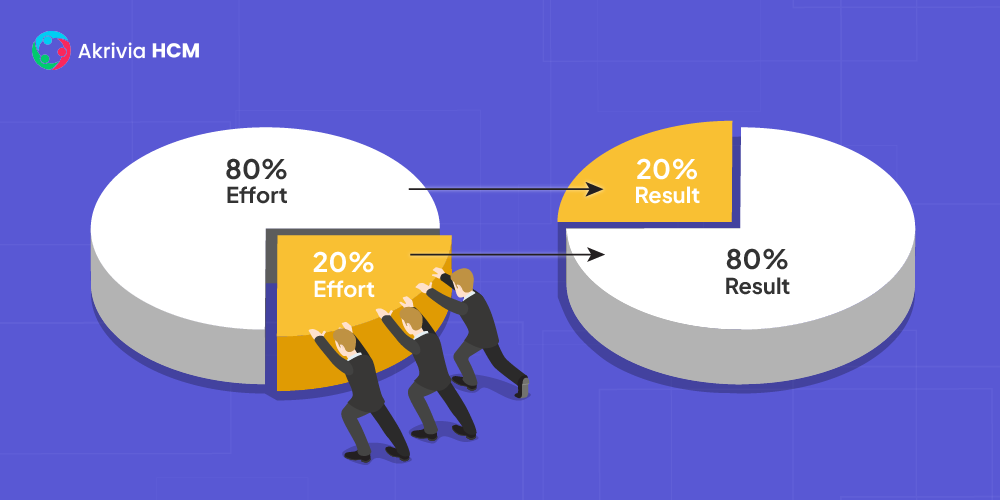Table of Contents

It is also known as the 80/20 Rule, which is a concept articulated by Italian economist Vilfredo Pareto asserting that 20 percent causes 80 percent results. The principle is a general reminder that outputs rarely match inputs.
He surveyed Italy, and that’s how he proved his theory because, at that time, the observation was very clear that 20% of the citizen were the owners of 80% of the land. Upon surveying other countries, he found this distribution trend to be held abroad. For instance, in any given country, 20 percent of the students in a class may account for 80 percent of the debate questions or quiz responses.
It can be applied in a wide range of areas, including management, human resources, and manufacturing. For example, the efforts of 20% of a corporation’s staff members could be responsible for 80% of the company’s profits. This idea has been adopted by various coaching and customer relationship management software programs.
It can also be helpful in personal situations, and many diffuse their efforts unproductively rather than focusing on the most critical activities. Regarding personal time management, 80% of your professional output could come from only 20% of your working hours.
In a Pareto chart, frequency is plotted against impact; frequent events can significantly affect the outcome more than infrequent events. It can be applied to provide insights into Key Performance Indicators (KPIs).
Pareto efficiency is a state of optimal distribution of resources in which no one can be made better without making another individual worse off.
A Pareto improvement is an action that advantages a person without reducing or eliminating the benefit to another.
The Pareto principle has been applied to the workplace in several ways, including the 96-minute rule. This principle states that employees should devote this much time daily to their most essential tasks to improve productivity.
It states that a few significant factors account for most of the results in many situations. Correctly allocating resources can increase efficiency and profitability, so it is important to understand this principle.
It is an excellent principle for business managers to organize their thoughts about resource allocation and make more intelligent decisions. The rule of diminishing returns is a fundamental principle of economics that shows that, as the number of inputs consumed increases, the marginal benefit of each additional output will fall.
The Pareto Principle can be helpful in resource allocation because it allows you to identify rewarding people and change direction. For example, if 20% of the car design flaws are responsible for 80% of the accidents, you can identify and correct those vulnerabilities. Similarly, suppose 20% of your customers generate 80% of your revenue. In that case, you may want to focus on rewarding their loyalty by giving them preferential treatment regarding customer service and product support.
While it is true that it holds much of the time, this does not necessarily make it a law. For example, 30% of workers may be responsible for 60% of output. In this case, the remaining employees may be less productive or may not be performing to the best of their abilities.
The Pareto principle determines which problems are the most significant and should be addressed first. It is an analytical tool that estimates the relative magnitudes of different issues and helps make effective decisions based on data in an organization. A Pareto diagram or table is a useful way to present statistical analysis results. The results often follow these two situations:
If you want to optimize the use of your time, then you know that, on average, only 20% of your activities and tasks contribute 80% of the results. The remaining 80% are marginal in terms of effectiveness. Because the Pareto Principle is a well-known rule, it shows that 80% of the result is achieved with 20% effort.
The Pareto Principle is a system for prioritizing tasks and setting goals. The principle states that 20 percent of the causes result in 80 percent of the effects; thus, identifying and focusing on these critical factors will allow you to save time. To succeed using this method, you need to assess your capabilities and level of performance, articulate your goal clearly, and identify the key result areas where you can make the biggest impact. It is also essential to recognize your strengths and weaknesses, so you can implement strategies that take advantage of your skills. On top of all this, ensure you have strategic planning for achieving your goal and stimulating work-life balance.

Applying the Pareto principle to your business can help you redirect resources for maximum efficiency and output. The 80/20 rule allows you to reduce your overall workload while increasing productivity, which leaves you with more time and energy to devote to the things that really matter in your business.
Let’s Recruit, Reward, and Retain
Your Workforce Together!
